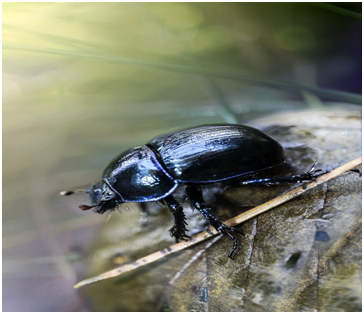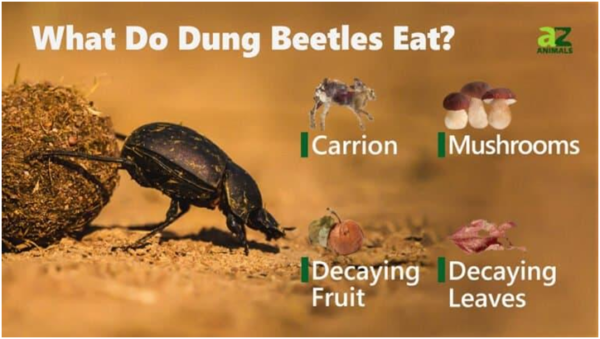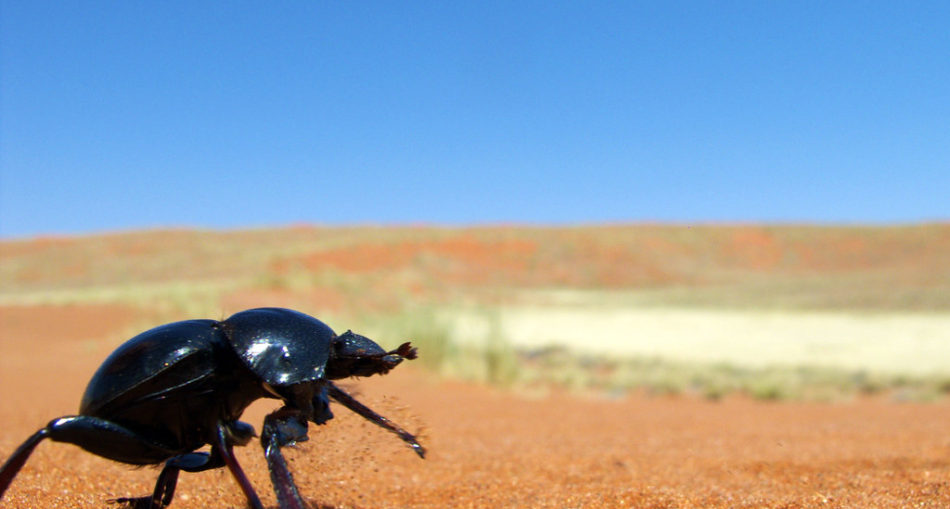
Photo of a Dung Beetle. Source: https://pixabay.com/photos/beetle-insect-leaf-dung-beetle-6062572/
Growing up I heard these beetles being referred to as “Cockle” , a name that would send chills down my spine. I was told that these beetles could crawl into your ear at night and make a nest in your head! But, don’t be too scared they’re just here for your… poop. Yes, you read that right – poop; we are going to dive into the fascinating world of these tiny environmentalists and learn about how they behave and how they are able to reduce greenhouse gas emissions.
Scientific Classification
Kingdom: Animalia
Phylum: Arthropoda
Class: Insecta
Order: Coleoptera
Infraorder: Scarabaeiformia
Superfamily: Scarabaeoidea
Description
Dung beetles are typically round, with short wing covers (elytra) that expose the abdomen’s end. They range in size from 5 to 30 mm (0.2 to 1.2 inches) and are typically dark in color, with some having a metallic luster. A long, curved horn protrudes from the top of the male’s head in many species.
Habitat
Dung beetles do not have a preference for dry or cold temperature and reside in every continent around the world EXCEPT Antarctica. They usually live in many habitats such as deserts, grasslands, savannahs, farmlands or forested regions.
Diet
Dung Beetles have quite an interesting diet, while most animals prefer their food to be whole and non-digested, the Dung beetle eats the liquid from animal dung. A few species feast on the dung of carnivores while others prefer a more appetizing meal such as mushrooms, carrion or decaying leaves and fruits.

Source of image: https://a-z-animals.com/blog/what-do-dung-beetles-eat/
Reproduction
Dung beetles can be placed into three main categories: Rollers, Tunnelers and Dwellers. All three types of dung beetle have their own special way in which they prepare their homes for reproduction.
- Rollers – These dung beetles, after finding that perfect pile of dung, will collect a part of the dung and start to sculpt it into a ball. After they would have compacted the dung into the ball shape they quickly roll it away using their hind legs. They take this dung ball to a burrow which was dug and place it inside. The female dung beetle lays her egg on top of the dung ball. When the larvae (grub) hatches they start to consume the dung for nourishment -Yum!
- Tunnelers – The tunnelers would dig a hole deep into the earth where they take piles of dung and clump them up into a spectacular poo mountain. Tunnelers usually have horns in order to fight off any male who might try to come around to try and steal dung. After a female dung beetle inspects this poo mountain and is pleased she would then lay her egg on it.
- Dwellers – Female dung beetles lay their eggs directly in the dung but this poses a threat, the tunnel that was dug may cause bacteria to start growing and causing infections to larvae that hatch.
Ecological Benefits
- Secondary seed dispersers – when birds or other animals defecate you might be able to find seeds in their droppings, because dung beetles bury these droppings they are essentially planting these seeds that will later sprout, becoming new plants. They’re also tiny farmers.
- Livestock produces a huge amount of dung that is beneficial to soil and because dung beetles bury this dung it brings it in contact to plants’ roots.
- Dung beetles can reduce methane production which is a potent greenhouse gas that is harmful to the atmosphere. Cow dung can produce methane that it releases into the air but because dung beetles burrow through the dung it creates tiny holes that bring oxygen into the soil.
Fun Facts
- Dung beetles navigate by reading the stars. They take mental snapshots of the milky way so that they can be able to travel in a straight line towards their burrow.
- They can bury 250 times their body weight. One species known as Onthophagus Taurus, the horned dung beetle can carry over 1000 times its own body weight.
- Some dung beetles live on the backsides of animals so they can collect dung when the animal defecates and some have a keen sense of smell and are able to locate feces that may be lying around.
- The Scarab, modeled after the dung beetle, was held sacred to the Ancient Egyptians and represented resurrection in Ancient Egypt.
- A South African plant, Ceratocaryum argenteum commonly referred to as Restiads, produces seeds that look and smell like dung so the dung beetle can bury them.
The next time there’s a pile of poop lying around maybe take a closer look and get a chance to see these tiny green salvagers and navigators. If Dung beetles did not take up the smelly job of rolling dung away then the world would be quite a mess. Hurray for these tiny recyclers!
Here’s a Dung Beetle joke: The Dung Beetle walked into a bar and asked “Is this stool taken?”
References:
- Dung Beetle: https://en.wikipedia.org/wiki/Dung_beetle
- Reproduction: Rollers, Tunnelers, Dwellers: https://kids.nationalgeographic.com/animals/invertebrates/facts/dung-beetle#:~:text=The%20rollers%20shape%20pieces%20of,actually%20live%20inside%20dung%20piles.
- Ancient Egyptian Scarab: https://www.thecollector.com/egyptian-scarabs/
- Navigate using the stars: https://www.nationalgeographic.com/animals/article/dung-beetles-milky-way-navigation#:~:text=Talk%20about%20star%20power%E2%80%94a,recent%20experiments%20in%20South%20Africa.







